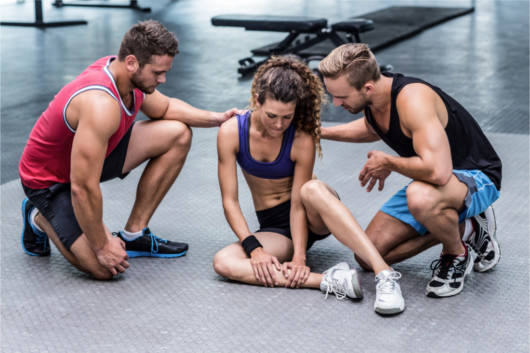Do you work out regularly? Are you wondering which gym injuries to look out for?
Exercise can have tremendous benefits. It can help you lose weight, lower your cholesterol, and lower your risk of heart disease and diabetes. It can help improve your memory and lower your risk of anxiety and depression. Weight lifting is a great way to boost your metabolism, especially as you get older. It builds muscle mass and serves to firm and tone your body. Yet workout injuries are common, and in most cases, avoidable.
What should you be protecting your body against? Let’s take a look.
1. Torn ACL
The anterior cruciate ligament (ACL) stabilizes your knee joint and connects your thighbone to your shinbone. If you’re using an improper stance or lifting weights that are too heavy, it can get torn. This is also a common injury with sports that involve sudden stops and turns, including soccer, tennis, or volleyball.
How to Avoid Knee Injury
To avoid problems, make sure that your knees are lined up with your hips and ankles when you lift. And focus on lighter weights with more repetitions rather than lifting weights that are too heavy. This puts pressure on your joints and makes injuries more likely.
2. Lower Back Strain
If you’re doing squats or deadlifts without a proper form, you may notice a twinge or pulling in your back. To avoid back strain, make sure you stand with your feet and hips shoulder-width apart. And make sure your weights aren’t too heavy.
How to Avoid back Strain Injury
You can also help avoid back injuries by wearing more supportive shoes. Make sure that they provide the proper shape and cushioning you need in order to be comfortable.
3. Rotator Cuff Injury
A rotator cuff is a group of muscles and tendons around the shoulder joint. They are what holds your upper arm bone in the shoulder socket. Rotator cuff injuries occur when you lift weights too frequently and don’t give the muscles and tendons a chance to rest in between workouts. You may experience shoulder pain at night, or weakness when you’re lifting your arm.
Rotator cuff injuries can get treated through steroid injections or physical therapy. A peptide may also speed up tissue repair. These injuries can also be repaired through surgery, such as tendon repair or shoulder replacement.
How to Avoid
To avoid muscle tear, keep your shoulder heads in proper alignment under your ears when lifting. Avoid hunching up, and don’t use weights that are too heavy. A good rule is to start with lighter weights and gradually increase as you get stronger.
4. Slipped Disc
A slipped disc in the back can occur when the outer ring of the spine becomes weak and torn. It can slip out of place while you are turning to lift an object. Exercises like squats can cause a slipped disc by putting extra strain or pressure on the lumbar region.
How to Avoid Slipped Disc Injury
Maintaining a healthy weight and using proper weight-lifting techniques can help you prevent the injury. Slipped discs are often treated non-surgically, with heat, ice, and pain relievers. If pain persists for a couple of months, surgery could become necessary.
5. Bicep Tendinitis
Bicep tendonitis is an inflammation around the tendons that connect the bicep muscles. They are often caused by exercises that use repetitive motion. These may include lifting weights, tennis, or swimming. Symptoms include shoulder pain and discomfort when using the forearm.
How to Avoid Bicep Tendonitis
Bicep tendinitis can be avoided with proper alignment during workout sessions. It’s treated with anti-inflammatory pain medications, ice packs, and steroid injections. Physical therapy may also be necessary.
6. Pectoral Injury
Pectoral muscles can tear when you use too much weight or force. They are common during exercises such as bench presses. Mild pulls can heal within a week or two after tearing. More serious strains, however, can take many months to heal. Some may even require surgery.
6. Shin Injury
Shin splints occur when you overload your leg muscles or shin bones. Symptoms include tenderness, soreness, and mild swelling in the lower leg.
How to Avoid Shin Splints
To avoid shin splints, don’t increase the intensity or duration of your workout suddenly. Use shoes with proper arch support, and consider adding strength training to your workout.
Shin splints are treated with ice, rest, and anti-inflammatory pain killers. You should not go back to working out at full speed until your injured leg feels as strong as your other leg. Try jogging, sprinting, or leaping. If you can do this without pain, you’re ready to get back to the gym.
8. Sprained Ankle
Sprained ankles are caused when your ankle is forced to move out of its normal position. This can cause one or more of your ankle’s ligaments to tear. It’s easy to roll your ankle when running on a treadmill. Symptoms include:
- ankle pain
- tenderness
- swelling
- bruising
They are often diagnosed with X-rays or MRIs. Sprained ankles are often treated with ice, rest, and elevation. Doctors may recommend a brace or physical therapy. You can restore your ankle’s range of motion, strength, and flexibility through rehabilitative exercises.
Speak to your doctor about when it’s safe to resume your workouts. In rare cases, surgery may be necessary to repair ligaments that won’t heal. Gym injuries such as back strains, sprained ankles, or torn rotator cuffs are common when you work out regularly. It’s critical to use proper alignment and posture to make sure your workouts are safe and productive. For more information on health and fitness, read our blog today. We publish a variety of lifestyle content regularly, do don’t miss out.
